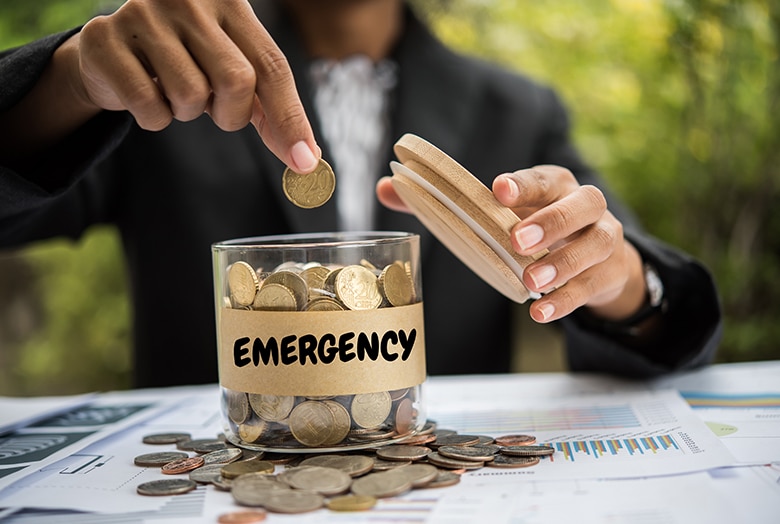From Zero to Secure: Growing Your Emergency Fund Efficiently

In the unpredictable journey of life, a financial safety net is not just a luxury—it’s a necessity. The sudden shock of a job loss, a major medical bill, or an unexpected home repair can quickly derail your financial stability, often leading to high-interest debt that takes years to pay off. The key to weathering these storms lies in a robust and well-managed Emergency Fund.
This comprehensive guide will walk you through the process of building an emergency fund, starting from scratch, and growing it efficiently to a secure and resilient financial buffer.
Phase 1: Setting Your Foundation and Defining the Goal (Zero to $1,000)
The first step in any successful journey is knowing your destination. Building an emergency fund can feel like a daunting task, but breaking it down into manageable goals makes the process achievable and motivating.
1. Define What Qualifies as an Emergency
First and foremost, establish strict rules for when you will access this money. An emergency fund is not for a vacation, a clearance sale, or a new gadget. It is strictly reserved for true emergencies like:
- Job loss or significant income reduction.
- Major, unexpected medical expenses.
- Essential and sudden home or car repairs (e.g., a burst pipe, a broken transmission).
Note: If you dip into the fund, even for a genuine emergency, your immediate financial priority must be to replenish it back to the target amount.
2. Set Your Target Amount
The gold standard recommendation from financial experts is to save enough to cover three to six months of essential living expenses.
- 3 Months of Expenses: A good starting point, especially if you have a very stable job and no dependents.
- 6 Months of Expenses: Recommended for most people, providing a comfortable buffer against job loss.
- 9 to 12 Months of Expenses: Ideal for self-employed individuals, those with irregular income, or single-income households with dependents.
To calculate your target, total your essential monthly expenses (rent/mortgage, minimum debt payments, utilities, groceries, insurance, transportation). Exclude discretionary spending like dining out or entertainment. Multiply this number by your target number of months.
3. The Starter Fund ($500 - $1,000)
A goal of six months’ expenses can be paralyzing. Start small. Your first mission is to save $500 to $1,000. This small cushion will cover most minor financial shocks (like a flat tire or a small deductible) without forcing you to use a credit card.
- Quick Wins: This initial stage is all about momentum. Sell unused items online, cancel non-essential subscriptions immediately, or work a few extra shifts to hit this target fast. The quicker you see progress, the more motivated you'll be.
Phase 2: Building Momentum with Automation (Growing Efficiently)
Once you have your starter fund, the focus shifts from finding quick cash to establishing a sustainable, efficient savings habit. This is where automation becomes your most powerful tool.
4. Create a Dedicated, Separate Account
Visibility breeds temptation. Keep your emergency fund physically and mentally separate from your daily banking.
- Where to Keep It: The best place for your emergency fund is in a High-Yield Savings Account (HYSA). HYSAs offer significantly higher interest rates than traditional savings accounts, meaning your money is growing passively and securely. They are:
- Liquid: Easily accessible when an emergency strikes.
- Secure: Usually FDIC-insured (or similar government-backed protection, depending on your country).
- Growing: The earned interest helps you reach your goal faster.
Crucially, choose an account at a different bank than your checking account. This slight barrier to access prevents impulsive transfers for non-emergencies.
5. Automate Your Contributions
Pay Yourself First. This is the golden rule of efficient saving. Treat your emergency fund contribution like any other non-negotiable bill (rent, mortgage, etc.).
- Set up an automatic transfer from your checking account to your HYSA to coincide with your payday. Even if it's a small amount—$25, $50, or $100—consistency is king.
- Budgeting: Integrate this transfer into your monthly budget before allocating money for discretionary spending.
6. Aggressively Attack Waste and Boost Income
To fuel your automated savings, you need more money flowing into the fund.
- The Budget Audit: Conduct a deep dive into your monthly spending. Can you save money on groceries by meal prepping? Can you negotiate lower rates for your internet or cell phone? Every dollar saved goes straight into the fund.
- The 'Found Money' Principle: Redirect all unexpected windfalls into your emergency fund. This includes:
- Tax refunds.
- Work bonuses.
- Unexpected cash gifts.
- Any pay raise—commit to saving the entire raise amount until your fund is fully stocked.
- Side Hustles: Consider temporary side gigs or freelancing. The income from a short-term side hustle can dramatically accelerate your fund-building timeline, turning months into weeks.
Phase 3: Securing and Maintaining the Buffer (Achieving Security)
Once you reach your target of three, six, or even twelve months of expenses, you’ve achieved a monumental financial milestone. Now, the focus shifts to protecting and optimizing this invaluable resource.
7. Protect the Funds from Yourself
The battle is won, but the war for financial discipline is ongoing. Ensure the money is guarded against non-emergency use.
- Don't Invest It: Keep your emergency fund safe from market volatility. It must be instantly liquid. Do not invest this money in stocks, bonds, or real estate—these assets carry risk and can be difficult or penalized to liquidate quickly. Stick to HYSAs or Money Market Accounts.
- Keep the HYSA: Continue to let the high interest rate work for you. Even once fully funded, the interest earned will help the fund keep pace with inflation over time.
8. Review and Adjust Regularly
Life circumstances change, and so should your emergency fund target.
- Life Events: Get married, buy a house, have a child, or switch to a commission-based job? Any major life change that increases your expenses or decreases your income stability should prompt a review and likely an increase in your target fund amount.
- Inflation Check: Annually review your essential expenses. Utility costs, rent, and food prices rise over time. Ensure the monetary value of your fund still covers your target number of months based on current costs.
9. What to Do Next
Once your emergency fund is fully funded and secure, you can redirect the "emergency savings payment" to your next financial priority. This is the definition of financial efficiency—you've created a powerful safety net and now have the bandwidth to pursue long-term wealth building. Potential next steps include:
- Aggressively Pay Down High-Interest Debt: (Credit cards, personal loans).
- Increase Retirement Contributions: Maximize tax-advantaged accounts like 401(k)s or IRAs.
- Start Saving for Other Goals: (e.g., a down payment on a house, college tuition, etc.)
Conclusion: Your Path to Financial Peace
The journey From Zero to Secure is a marathon, not a sprint. It requires discipline, automation, and a clear understanding of your goals. By defining your target, automating your savings into a high-yield account, and maintaining strict boundaries on its use, you transform a distant wish into a solid reality.
An emergency fund is more than just money; it is financial peace of mind. It allows you to face unexpected challenges with confidence, protecting your future, your credit, and your sanity. Start with that first $500 today, build the habit, and watch your safety net grow until you achieve true financial security.

Related